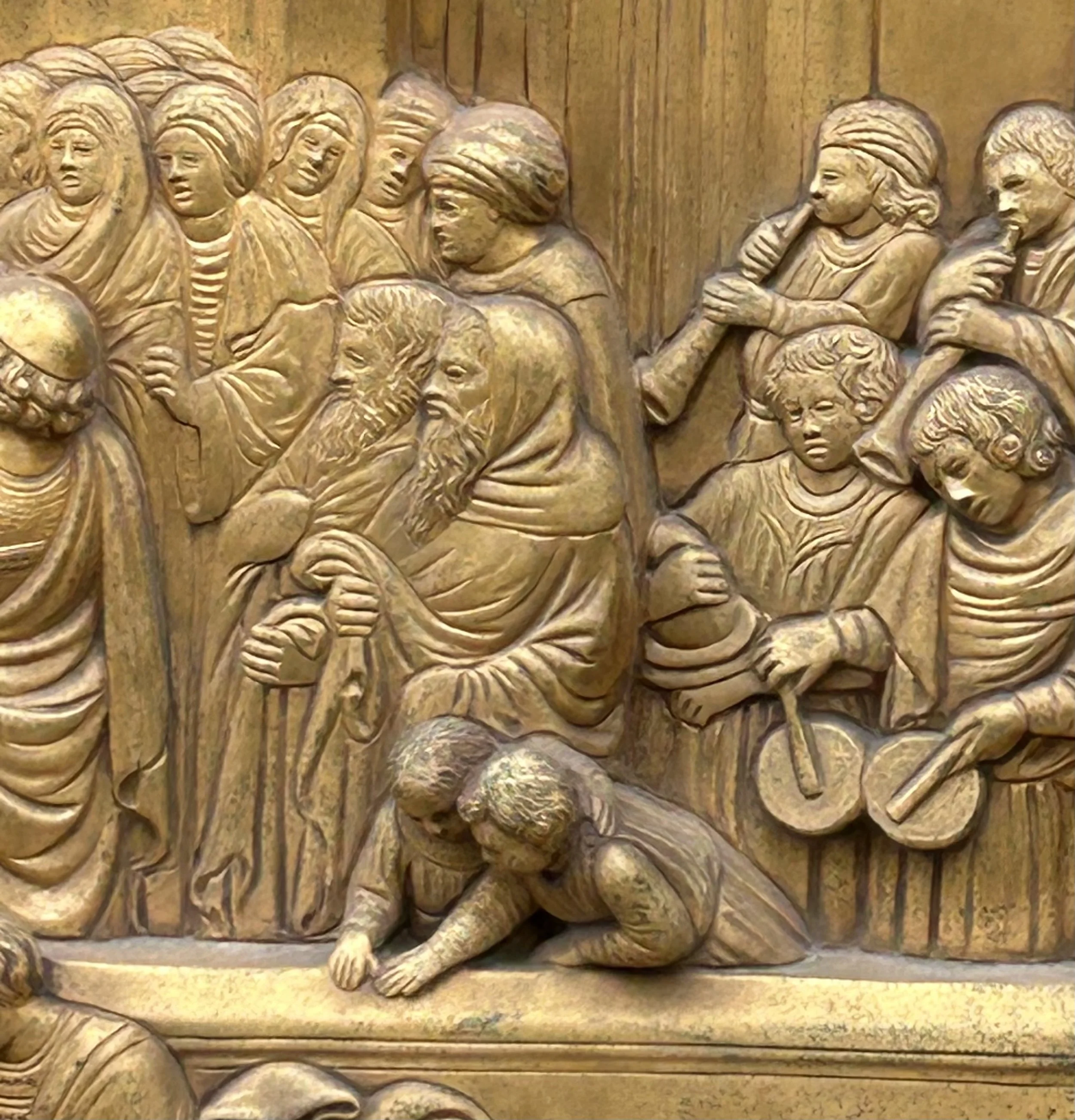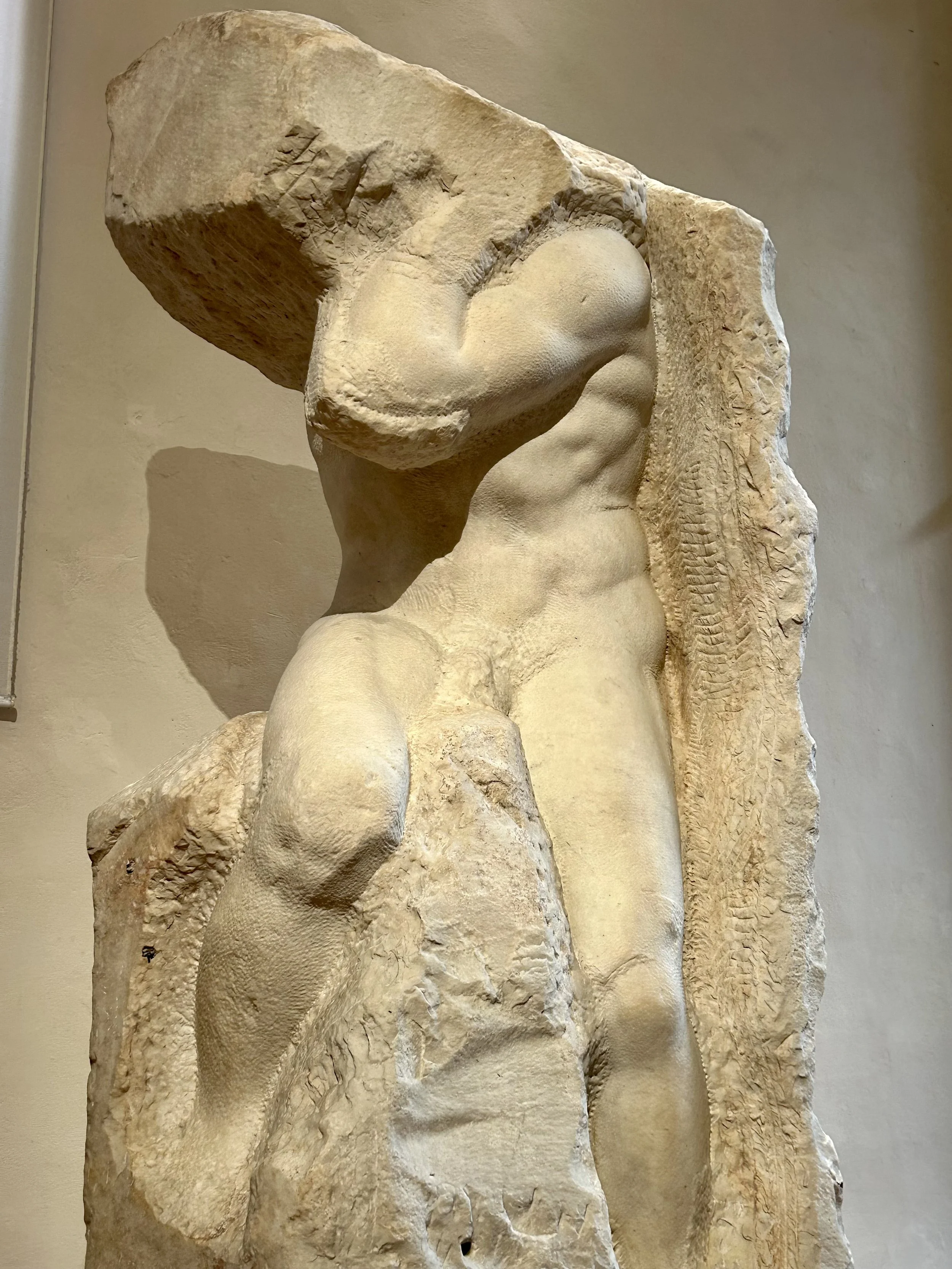It was in 1975, entering art school, that I was first truly exposed to the treasure trove of Italian Renaissance artwork. Up until then, the only names familiar to me were Michelangelo (see below for more about that) and Leonardo (this was before the Teenage Mutant Ninja Turtles, mind you.) Thanks to my professors, the hefty Gardner textbook and the charming, cozy school library, I was quickly educated. Giotto, Botticelli, della Francesca, Masaccio, Donatello, Ghirlandaio, Fra Angelico and many others were soon added to my mental Rolodex, and have been ever since. I was drawn to the amazing work itself, of course, but also the romanticism of a time in art history which forever changed the course of the western cultural world. The history of that era enthralled me. Stories of the Medici influence, sculptors attending undercover autopsies from which to learn anatomy, engineering feats that made free-standing statues possible and papal power plays. I drank it all in, greedily.
No tale of that period captured me more than the creation of the Baptistry doors in Florence. It is a story that showcases artistic persistence, triumph of the underdog, and technical prowess. The result, especially the east-facing set of doors, became a touchstone in my artistic soul - a perfect combination of history, inspiration and craft (more on that later as well) that placed Florence high up in my list of places to visit.
Last month, I finally made that pilgrimage. Five full days in Florence to take in as much as possible - the museums and churches, along with chianti, truffles, balsamic vinegar, pasta dishes galore and transcendent coffee drinks. Needless to say, it was an adventure to remember. Out of all the sites, the one I was looking forward to the most were the bronze doors Michelangelo deemed "the Gates of Paradise.” Foregoing the originals in the Duomo Museum (I preferred the experience of seeing them in situ, the better to imagine myself in the Quattrocento), I visited them a half dozen times during my stay. Luckily, our hotel was just three blocks from the Piazza, making it an easy and pleasant walk, day or evening. My first pilgrimage was actually after dark when there were few people about, and, even though it wasn’t illuminated, the golden facade glittered and the shadows created a dreamlike cast. I scanned each panel, marveling at the use of perspective and the superb storytelling each one achieved. I drifted back into Sunday School, but with an aesthetic air.
East Doors of Battistero di San Giovanni (Gates of Paradise), completed 1447 - Lorenzo Ghiberti
Prisoner Sculptures
Atlas Slave, 1525-30 - Michelangelo
Another memorable moment during our trip occurred the very next day at the Galleria della Accademia, which, like the Duomo and Baptistry, was within easy walking distance from our hotel. This gallery is the home of Michelangelo’s David, familiar to the entire western world. With good cause, as it is truly a perfect figure sculpture, more jaw-dropping in person than any image of it can impart. Impressed with Dave as I was, what struck me more profoundly were the rows of Prisoner figures, also by Michelangelo, that lined the corridor leading up to the main rotunda. These are unfinished pieces, originally intended for the Tomb of Pope Julius II in Rome. Not completed, but powerful nevertheless. They each contain an energy that is palpable. You can almost smell the sweat coming off the struggling men as they attempt to break their bonds.
Gazing at this series, I was surprised to feel a confusing emotional tug that came out of nowhere. Then I realized what it was. It was a memory of my father introducing me to the universe in which I would spend my life exploring - the art world. In his extensive library which held mostly classics, collections of poetry, history and 20th century novels, there lay flat on the bottom shelf, a portfolio of black & white photographs of Michelangelo’s sculpture. It was one of the only art books he owned. Memories of him showing me what was, to him, the perfect combination of art and craftsmanship, came roaring back into my head here in this shrine where I now stood. At sixty-eight years old, I was standing in front of one of the seeds he planted, unknowingly or not, that formed my identity, leading me into a lifetime of visual storytelling.
My Collection - David Loeffler Smith
Tree on the Hill II, 2010 - David Loeffler Smith
Since I often write in these blog posts about my influences, I thought it appropriate to showcase some of my personal collection. These are works, primarily by friends and colleagues past and present, that I draw inspiration from and am proud to have in my possession. Each month I’ll pull one out to talk about and display proudly.
It’s my pleasure to begin this series with a painting by the professor at Swain who almost singlehandedly hi-jacked me from the Design Dept. and seduced me to join the world of Painting. There are many stories about David I could tell, but what stands out in most of them is the air of gentlemanly politeness with which he imparted his wisdom. To me, he embodied the term “formal criticism.” Upon perusing a student’s work, he would often start with a kind intro, such as, “You’re seeing well,” before thoughtfully making a point. If he wanted to illustrate something on the piece itself, he would ask, “May I touch it?” before mixing a spot of color on the palette, often with his finger, and swiping on the PERFECT solution to a troublesome spot. It was maddening and sometime magical to a twenty-something painter.
David passed in 2012 and I’m proud to own one of his small, succinct paintings. I hope you enjoy it.



